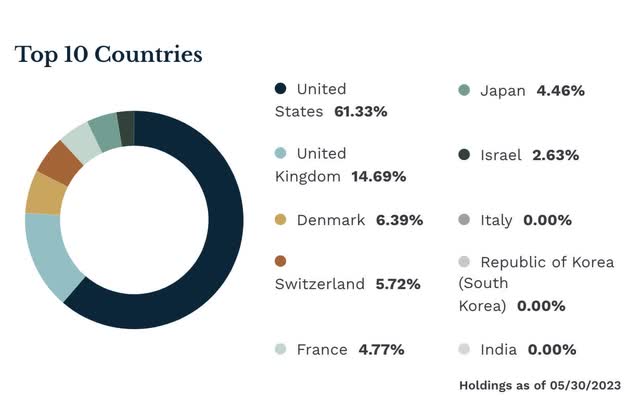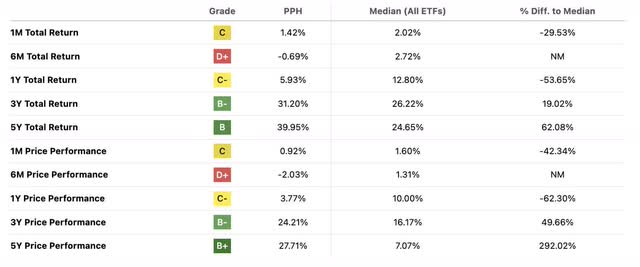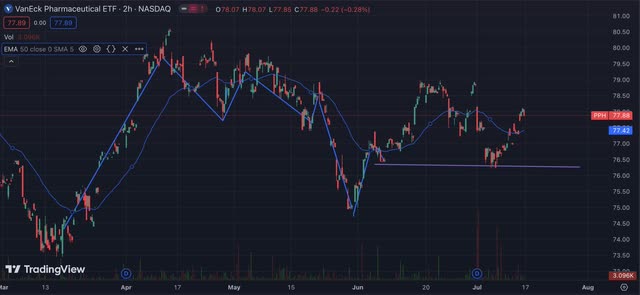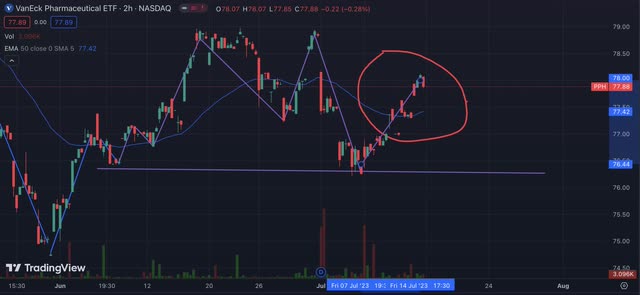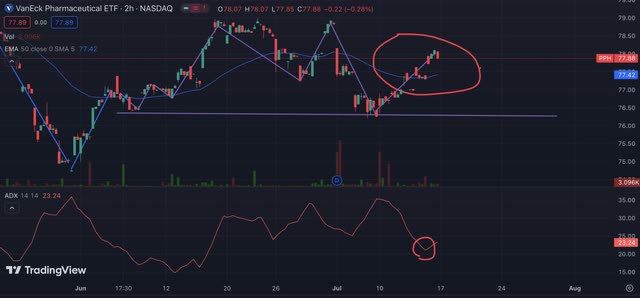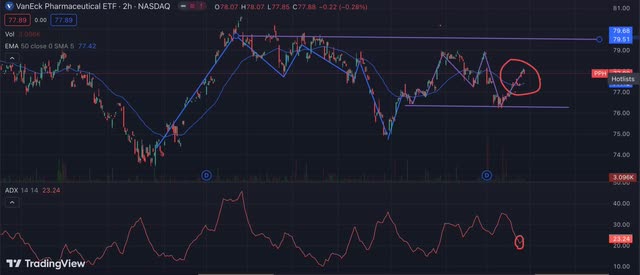PPH: Unnecessary Volatility In A Relatively Stable Healthcare Sector (Technical Analysis)

Summary
- Pharmaceutical ETFs like PPH may introduce another layer of risk that could be avoided if one took a broader approach to healthcare investing.
- Technical Analysis displays that beneath the most recent uptrend, PPH is largely struggling to gain the same momentum seen back in March and is likely to remain range bound.
- Artificial Intelligence could enhance both the precision and speed of drug development and personalization, making PPH's long-term forecast potentially lucrative.
- I rate PPH a Sell, as it's difficult to envision this ETF gaining enough momentum to break above the resistance level created in April, especially with economic uncertainty and monetary tightening in the picture.
SweetBunFactory
Healthcare assets have historically outperformed during tough economic periods, and are therefore a prime choice for many long-term and risk-averse investors. By narrowing healthcare focus towards more niche groups like pharmaceuticals, I believe one is likely creating unnecessary risk and volatility without generating potential returns of the same caliber. This is a result of greater concentration risks and threats that are specific to pharmaceuticals. For these reasons, I rate the VanEck Pharmaceutical ETF (NASDAQ:PPH) a Sell.
When comparing PPH and the iShares Biotechnology ETF (IBB) to the Fidelity MSCI Health Care Index ETF (FHLC), PPH and IBB seemingly generate stability problems compared to if one just took a broader approach to healthcare investing. ETFs that are more narrowly focused on niches like biotechnology or pharmaceuticals oscillate heavier and tend to deliver similar or subpar returns than more broadly-focused funds.
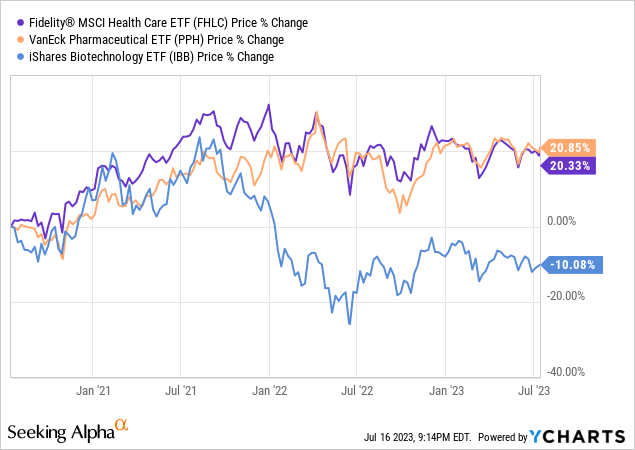
Strategy and Holdings Analysis
PPH tracks the MVIS US Listed Pharmaceutical 25 Index and uses a full replication technique. Securities within this index are weighted by market capitalization, which must be at least $1B. Individual holdings are capped at 10%, making PPH technically diversified according to the Securities and Exchange Commission (SEC). Furthermore, such stocks must also have a minimum daily trading volume of 50,000 shares.
This ETF invests in healthcare stocks within a variety of locations that include but are not limited to the United States, the United Kingdom, and Denmark. This exclusive sector focus combined with geographical diversity reflects the healthcare sector's strong international presence.
Individual holdings within PPH are quite dispersed, with the Sanofi (SNY) representing just over 5% of this fund and the top 10 holdings falling just short of half this ETF's total composition. This makes PPH almost equally weighted.
Investors might want to consider how they could spare themselves from concentration risk for the price of momentum.
Technical Analysis
PPH most recently peaked in April before incurring a downtrend from which it's yet to break even from. As seen in the chart below, this ETF made two new lows before a more sudden decline in the second half of May.
PPH broke back above the 50-day exponential moving average (EMA) in early July after rebounding from the same level of support that propelled it above the 50-day EMA roughly a month before.
Despite this reinstated momentum, I believe this rebound will likely not last based on movement in the average directional index (ADX).
Historically, the downtrends in this ETF have gained more momentum in shorter periods of time compared to the uptrends, and this last price increase was relatively weak based on how the ADX declined sharply at the base. I believe the most recent increase in the ADX signifies a future bearish movement. Therefore, PPH still has a downside for the time being and is likely still range bound between the two support and resistance points (labeled in purple) seen in the graphic below.
Pharmaceuticals and Artificial Intelligence
Artificial Intelligence (AI) has and will likely continue to enhance operations within many industries, pharmaceuticals just being one. I believe specific processes like drug discovery and personalized medicine have relatively large margins for improvement.
Drug Discovery
AI is resolving many barriers within drug discovery, such as identifying new drug targets, designing new molecules, and analyzing vast amounts of data for clinical trials. Companies capitalizing on this trend include but are not limited to Exscientia plc (EXAI), AbCellera Biologics (ABCL), and Recursion Pharmaceuticals (RXRX).
Personalized Medicine
AI is also revolutionizing the way personal medicine is practiced. This primarily involves overcoming the barriers like the lack of data and the high cost associated with developing personalized treatments. AI's ability to quickly analyze large amounts of data can speed up the process of matching patients with the right medicines and even make customized drugs. Companies capitalizing on this trend include but are not limited to BioXcel Therapeutics (BTAI) and Insmed Incorporated (INSM).
Threats to the pharmaceuticals industry and PPH
Capital intensity and regulatory risk
The demand for healthcare products such as pharmaceuticals is somewhat inelastic, however, their associated operations are far from cheap. Therefore, pharmaceutical companies are vulnerable to economic downturns in their own way. Furthermore, the rules and regulations surrounding new medicines and procedures are constantly changing, and are generally quite strict. Pharmaceutical companies are also often under heavy scrutiny by government regulators, patient advocacy groups, and the media in general. This may add an extra layer of volatility to PPH that investors might want to be aware of.
Ethical Dilemmas and liabilities
Similar to the healthcare sector as a whole, pharmaceutical securities bring their own risk that stems from their involvement in human life. For example, Novo Nordisk (NVO) recently made headlines after their diabetes drug Ozempic and weight-loss treatment Saxenda allegedly prompted suicidal ideations in some users. Though the stock price didn't react adversely, this doesn't mean a similar event can't shake the pharmaceutical industry in the future.
Conclusion
The pharmaceutical industry is well-positioned for growth in the long term but may have extra layers of volatility compared to healthcare as a whole. Furthermore, technical analysis of PPH may indicate that this ETF continues to fight an uphill battle after its most recent dip. For these reasons, I rate PPH a Sell.
This article was written by
Analyst’s Disclosure: I/we have no stock, option or similar derivative position in any of the companies mentioned, and no plans to initiate any such positions within the next 72 hours. I wrote this article myself, and it expresses my own opinions. I am not receiving compensation for it (other than from Seeking Alpha). I have no business relationship with any company whose stock is mentioned in this article.
Seeking Alpha's Disclosure: Past performance is no guarantee of future results. No recommendation or advice is being given as to whether any investment is suitable for a particular investor. Any views or opinions expressed above may not reflect those of Seeking Alpha as a whole. Seeking Alpha is not a licensed securities dealer, broker or US investment adviser or investment bank. Our analysts are third party authors that include both professional investors and individual investors who may not be licensed or certified by any institute or regulatory body.
